#Sony Alpha a6600
Explore tagged Tumblr posts
Text

i see you
1 note
·
View note
Text
0 notes
Link
Check out this listing I just added to my Poshmark closet: Sony a6500 Body only or kit lens
0 notes
Text
🎥What Cameras YouTubers Use for Facecam?📸

🌟Hey there, fellow content creators! If you've ever wondered about the magic behind those crystal-clear Facecams in your favorite YouTubers' videos, you're in the right place! 🤩
🤩📸Heres a detailed breakdown of these cameras and more tips on creating awesome Facecam content, check out my latest blog post here: https://guideclever.com/what-cameras-youtubers-use-for-facecam/
I've been doing some research and chatting with some fellow creators, and here are a few camera options that seem to be popular for Facecams:
1️⃣ Sony Alpha series (e.g., A6400, A6600): Known for their superb autofocus and image quality, these mirrorless cameras are a top pick among many content creators.
2️⃣ Canon EOS M50 Mark II: Compact, versatile, and budget-friendly, this Canon model is fantastic for Facecams and vlogging.
3️⃣ Logitech Brio: If you're looking for a high-quality webcam option, the Logitech Brio is a reliable choice with 4K capabilities.
4️⃣ Panasonic Lumix GH5: Loved by vloggers and YouTubers, the GH5 offers excellent video quality and advanced features.
5️⃣ Sony ZV-1: Another popular choice for vloggers and YouTubers, this compact camera is known for its excellent autofocus and versatility.
Remember, the right camera for your Facecam depends on your budget, needs, and style of content. Research thoroughly, read reviews, and consider what features matter most to you.
Feel free to share your camera recommendations or ask questions in the comments! Let's help each other level up our content game! 🚀
0 notes
Text
0 notes
Text
10 BEST CAMERAS TO USE TODAY 2023!
10 Best Cameras To Use Today!
Sony Alpha a7 III: This full-frame mirrorless camera offers exceptional image quality, high-resolution, and impressive low-light performance, making it popular among both professionals and enthusiasts.
⦁ 24.2-megapixel full-frame Exmor R CMOS sensor
⦁ 693-point phase-detection autofocus system
⦁ ISO range of 100-51200 (expandable to 50-204800)
⦁ 5-axis in-body image stabilization
⦁ 4K video recording capabilities
⦁ Dual SD card slots
Buy Now: https://amzn.to/3NBS3Ai
Canon EOS R5: Canon's flagship mirrorless camera boasts a high-resolution sensor, advanced autofocus, and 8K video capabilities, making it a top choice for photographers and videographers.
⦁ 45-megapixel full-frame CMOS sensor
⦁ Dual Pixel CMOS AF with 1053 autofocus points
⦁ ISO range of 100-51200 (expandable to 50-102400)
⦁ 8K video recording capabilities
⦁ In-body image stabilization
⦁ Dual memory card slots (CFexpress and SD
Buy Now: https://amzn.to/3Pl4Gkw
Nikon D850: This full-frame DSLR camera from Nikon features a high-resolution sensor, fast autofocus, and excellent dynamic range, making it a versatile and reliable option for various genres of photography.
⦁ 45.7-megapixel full-frame CMOS sensor
⦁ 153-point autofocus system with 99 cross-type sensors
⦁ ISO range of 64-25600 (expandable to 32-102400)
⦁ 4K UHD video recording capabilities
⦁ 7 fps continuous shooting (9 fps with optional battery grip)
⦁ Tilting touchscreen display
Buy Now: https://amzn.to/3CxCDqn
Fujifilm X-T4: Known for its retro design, this mirrorless camera from Fujifilm offers outstanding image quality, in-body image stabilization, and a wide range of film simulations, appealing to both professionals and enthusiasts.
⦁ 26.1-megapixel APS-C X-Trans CMOS 4 sensor
⦁ 425-point phase-detection autofocus system
⦁ ISO range of 160-12800 (expandable to 80-51200)
⦁ 4K video recording capabilities
⦁ In-body image stabilization
⦁ Weather-sealed body construction
Buy Now: https://amzn.to/3JlMZgS
Panasonic Lumix GH5: The Lumix GH5 is a mirrorless camera favored by videographers for its exceptional video capabilities, including 4K recording, high bit rates, and advanced image stabilization.
⦁ 20.3-megapixel micro four-thirds Live MOS sensor
⦁ 225-point contrast-detection autofocus system
⦁ ISO range of 200-25600 (expandable to 100-25600)
⦁ 4K video recording up to 60 fps
⦁ 5-axis Dual I.S. 2 image stabilization
⦁ High-resolution electronic viewfinder
Buy Now: https://amzn.to/3JlMZgS
Sony Alpha a6600: This APS-C mirrorless camera combines excellent image quality, fast autofocus, and impressive video performance, making it suitable for both photography and videography needs.
⦁ 24.2-megapixel APS-C Exmor CMOS sensor
⦁ 425-point phase-detection autofocus system
⦁ ISO range of 100-32000 (expandable to 50-102400)
⦁ 4K video recording capabilities
⦁ 5-axis in-body image stabilization
⦁ Real-time Eye AF and Tracking AF
Buy Now: https://amzn.to/46cgV8G
Canon EOS 5D Mark IV: The EOS 5D Mark IV is a full-frame DSLR camera that offers high-resolution images, excellent low-light performance, and advanced autofocus, making it popular among professional photographers.
⦁ 30.4-megapixel full-frame CMOS sensor
⦁ 61-point autofocus system with 41 cross-type sensors
⦁ ISO range of 100-32000 (expandable to 50-102400)
⦁ 4K video recording capabilities
⦁ Dual Pixel CMOS AF
⦁ Dual memory card slots (CF and SD)
Buy Now: https://amzn.to/3qG4G44
Nikon Z6 II: This full-frame mirrorless camera from Nikon excels in low-light conditions, provides fast and accurate autofocus, and offers robust video capabilities, making it a versatile choice for various genres.
⦁ 24.5-megapixel full-frame CMOS sensor
⦁ 273-point phase-detection autofocus system
⦁ ISO range of 100-51200 (expandable to 50-204800)
⦁ 4K UHD video recording capabilities
⦁ 5-axis in-body image stabilization
⦁ Dual memory card slots (CFexpress and SD)
Buy Now: https://amzn.to/3qQv8Z3
Olympus OM-D E-M1 Mark III: Known for its compact size and exceptional image stabilization, this micro four-thirds mirrorless camera from Olympus is popular among travel and wildlife photographers.
⦁ 20.4-megapixel micro four-thirds Live MOS sensor
⦁ 121-point all cross-type phase-detection autofocus system
⦁ ISO range of 200-25600 (expandable to 64-25600)
⦁ 4K video recording capabilities
⦁ 5-axis in-body image stabilization
⦁ Weather-sealed body construction
Buy Now: https://amzn.to/3qMSBua
Leica Q2: The Leica Q2 is a high-end compact camera with a full-frame sensor, excellent image quality, and a fixed 28mm lens, making it a preferred choice for street and documentary photography.
⦁ 47.3-megapixel full-frame CMOS sensor
⦁ Contrast-detect autofocus system
⦁ ISO range of 50-50000
⦁ 4K video recording capabilities
⦁ Built-in Summilux 28mm f/1.7 ASPH lens
⦁ Weather-sealed body construction
Buy Now: https://amzn.to/43
1 note
·
View note
Text
Buy Sony Alpha A6600 Mirrorless Camera
Buy a Sony Alpha A6600 mirrorless camera in London, UK. Get 4K recording and Big battery life, 11 fps and 24.5 Mega Pixels. Shop now!
0 notes
Video
Sony a6600 Mirrorless Camera in 2020 with 18 135mm Lens REVIEW
0 notes
Video
20220518-15-Cherry and chocolate cake at Cinnamon and Cherry in Franklin by Roger Wong
#2022#Australia#Cinnamon and Cherry#Franklin#Roger T Wong#SEL1655G#Sony 16-55#Sony A6600#Sony Alpha 6600#Sony E 16-55mm f2.8#Tasmania#cafe#lunch
7 notes
·
View notes
Link

0 notes
Text
Dual APS-C Hybrid Cameras - Fujifilm X-T3 vs Sony Alpha 6600 (A6600)
Dual APS-C Hybrid Cameras – Fujifilm X-T3 vs Sony Alpha 6600 (A6600)
[ad_1]
7
Well established in the APS-C hybrid market, Sony and Fujifilm find themselves face to face with their two high-end models in the segment. Here is the duel between the Sony Alpha 6600 (A6600) and the Fujifilm X-T3.
Fujifilm X-T3
View On WordPress
0 notes
Text
HND1 Photography Report Task: Capture & Output
DIGITAL CAMERA SENSORS A digital camera uses an array of millions of tiny light cavities or "photosites" to record an image. When you press your camera's shutter button and the exposure begins, each of these is uncovered to collect photons and store those as an electrical signal. Once the exposure finishes, the camera closes each of these photosites, and then tries to assess how many photons fell into each cavity by measuring the strength of the electrical signal. The signals are then quantified as digital values, with a precision that is determined by the bit depth. The resulting precision may then be reduced again depending on which file format is being recorded (0 - 255 for an 8-bit JPEG file).
Digital Camera Sensor Types Medium Format Medium format is the largest sensor type in digital cameras for photographic applications. However, it doesn’t come in just one size. Medium format has its own group of sensors, with its own equivalents to the four thirds, APS-C, and full-frame formats. There are a variety of sensor sizes for medium-format cameras, and typical sizes range from around 43.8×32.9mm to 53.7×40.2mm.
Due to their large image sensors, medium-format DSLR cameras are traditionally heavier and bulkier than their full-frame counterparts. But that changed, as brands like Hasselblad have come out with smaller mirrorless medium-format cameras like the X1D II to provide photographers with a lighter, more compact option. The newer Fujifilm GFX 100 is also a medium-format mirrorless camera and holds a whopping 102MP resolution.
35mm Full-Frame Full-frame sensors are available in both DSLR and mirrorless cameras. They have the same dimensions as the 35mm film, hence the name. The 35mm full-frame sensor type is the gold standard among professional photographers who want the highest-quality images.
The dimensions of a 35mm sensor are typically 36×24mm.
The Canon EOS R5, for example, is a full-frame mirrorless camera option, and the popular Nikon D850 DSLR has a FX full-frame sensor.
APS-H The groundbreaking EOS-1D was the first Canon camera to carry the APS-H sensor type was, and it launched in 2001. Canon released four more cameras (all members of the 1D line) with the same sensor type before discontinuing it.
The APS-H is slightly larger than the APS-C sensor format that many Canon DSLR cameras use today but smaller than a traditional full-frame sensor.
APS-C The APS-C or crop-sensor format is the most well-known and most versatile of the bunch. The APS-C sensor is popular in DSLR and mirrorless cameras alike. Beginners and professionals alike use it thanks to its adaotability.
The typical APS-C sensor size is different across camera brands. Canon APS-C sensors are usually 22.3×14.9mm, while other brands like Nikon, Sony, Pentax, and more usually feature APS-C sensors with 23.6×15.6mm dimensions. Many cameras including the Canon EOS M50 Mark II, Fujifilm X100V, Sony Alpha a6600, and Nikon Z50 all hold APS-C sensors
Four Thirds/Micro Four Thirds Created by Olympus and Panasonic, the Four Thirds System is a standard that allows for the compatibility of lenses and bodies across participating camera makers. Image sensor size is 17.3×13mm with a crop factor of 2.0 when compared to full-frame camera sensors.
On the mirrorless camera side, we have the Micro Thirds Format System, first released in 2008. It shares the Four Thirds System’s sensor size and specifications but uses a compact design with no space for the movable mirror, pentaprism, and other parts of the DSLR mechanisms not found in mirrorless cameras.
The Four Thirds System uses a 4:3 image aspect ratio, hence the name, and is featured in cameras like the Blackmagic Design Pocket Cinema Camera 4K. The Micro Four Thirds System uses the same ratio but can also record 16:9, 3:2, and 1:1 formats, and is included in cameras like the Olympus OM-D E-M1 Mark III and Panasonic Lumix G9.
1” Type (and below) Any sensor that is about 1.5 to 1-inch in size or smaller can be found in non-interchangeable lens cameras (your typical point and shoot) and smartphone cameras.
High-end compact cameras like the Panasonic Lumix DMC-LX10 and the Sony Cyber-Shot DSC-RX10 IV use 1-inch sensors, allowing these cameras to produce good results—in terms of image and video quality—that you won’t get with regular point-and-shoot cameras.
Dynamic Range
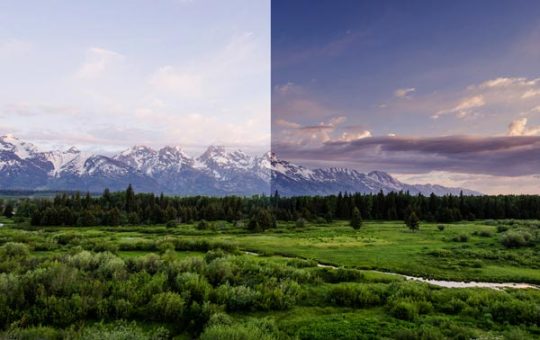
If you’ve ever had to take a photograph on a bright sunny day, chances are pretty high that you would have lost detail, possibly in the shadows or in the highlights, perhaps even both. This is not an exposure problem on your part, it’s more likely a limitation of the dynamic range of your camera – almost all cameras will come up against this problem at some time.
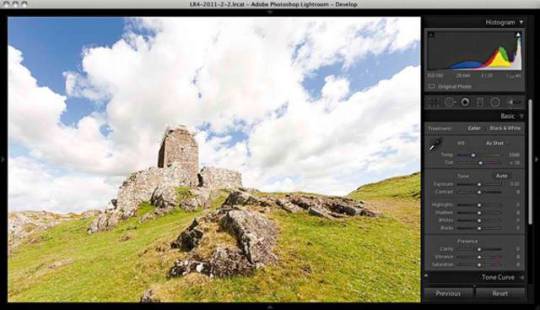
Notice the sky is lacking in detail. It is over exposed – outside of the range of the camera. There are actually two dynamic ranges you need to think about. One is the dynamic range of the subject, the second is the dynamic range of your camera. The dynamic range of the subject is a measure of the range of light intensities from the shadows to the highlights. In low light conditions the dynamic range (that is the difference between the darkest and the latest part of the subject) is quite small. On a bright sunny day that range is much higher and is often outside the range of the camera. Different cameras and different sensors will have bigger or smaller dynamic ranges. As long as the dynamic range of the subject doesn’t exceed the dynamic range of your camera you will be able to get a perfectly exposed photograph.
If the subject dynamic range is bigger than the cameras dynamic range and one part of your subject will be either under or over exposed. You can easily tell if the subject’s dynamic range exceeds that of your camera by using the histogram on your rear screen.
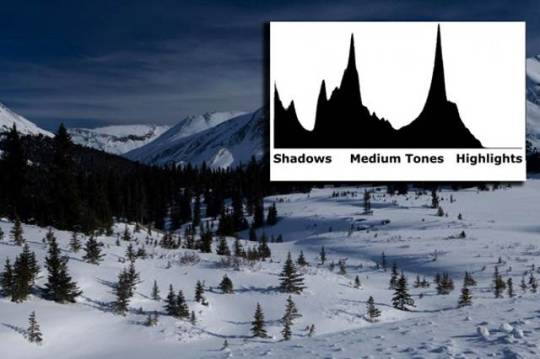
The histogram shows the range of subject brightness starting with black on the left going to white on the right. The width of the histogram chart represents the dynamic range of your camera sensor.
If the histogram fits inside of the histogram display area then the dynamic range of the subject is inside that of your camera and everything is good. If the histogram is clipped at either end then the subject range is too wide. Try changing your camera exposure and watch the histogram move left or right and see if you can fit the histogram inside of the display.
On the histogram shown you can see you can see the shadow area is outside of the sensor’s ability to register. The signal is “clipped” with no details being recorded. The left side of the histogram is crammed up tight against the edge, showing lack of detail.
On the right of the histogram there is still room – the photographer could open up the iris (or use a slower shutter speed) and get more detail in the shadow area without sacrificing detail in the highlights.
Be careful not to over expose the highlights!
A blown out highlight looks terrible whereas a shadow lacking detail is acceptable.
If the subject’s dynamic range is too big and will not fit in histogram and then you need to choose where you will lose information. Ninety-nine percent of the time a photograph that is exposed so the highlights have full detail and the shadows just go black with no detail is a much better option and gives a much more pleasing photograph than one where there is full detail in the shadow but where the highlights are completely burned out.
The almost golden rule is “expose for the highlights,” that is, expose so the highlights are not clipped. Shadows by definition are dark and it is hard to see detail there, so, if you have to loose a portion of the dynamic range it is almost always preferable to loose in the shadows.
There are ways to lift shadows – consider using a fill in flash or a reflector to lighten up those areas if they are close enough to the flashgun that it would have an effect.
Another option – and always a good piece of equipment to have in your camera kit – is to use a graduated neutral density (ND) filter.
BIT DEPTH
Bit depth is one of the most fundamental and important parameters you're likely to come across in photography and videography. This great video will give you a quick introduction to what bit depth is and why it matters to your work.
Coming to you from ZY Productions, this quick and informative video will teach you about bit depth. Bit depth is essentially how much information your camera can store in each color channel for each pixel. For example, a camera with 8-bit color depth can store a string of eight 0s and 1s in each color channel for each pixel. Since there are two possibilities (0 or 1) in each slot and eight slots overall per channel, that equates to 2^8=256 values per channel. Since there are three overall channels, this equates to (2^8)^3=16,777,216 total colors. Altogether, higher bit depths are better, as they create finer gradations, and this results in smoother transitions between tones. As the video notes, the standard JPEG is 8-bit, whereas raw files are typically 12-bit or 14-bit files. This is by far one of the best reasons to shoot in raw; the massive gain in information you get from those extra bits creates much more post-processing latitude. Check out the video above for more.
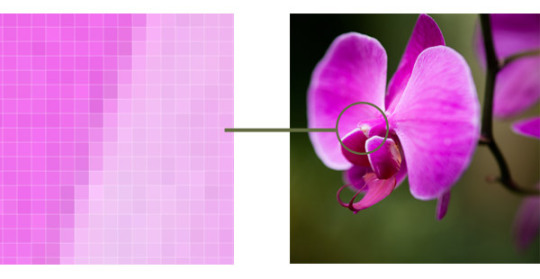
there is some lin with video about bit depth:
https://youtu.be/Z-0hszXbYD0
DIGITAL NOISE
Digital camera image noise
"Image noise" is the digital equivalent of film grain for analogue cameras. Alternatively, one can think of it as analogous to the subtle background hiss you may hear from your audio system at full volume. For digital images, this noise appears as random speckles on an otherwise smooth surface and can significantly degrade image quality. Although noise often detracts from an image, it is sometimes desirable since it can add an old-fashioned, grainy look which is reminiscent of early film. Some noise can also increase the apparent sharpness of an image. Noise increases with the sensitivity setting in the camera, length of the exposure, temperature, and even varies amongst different camera models.
CONCEPT: SIGNAL TO NOISE RATIO
Some degree of noise is always present in any electronic device that transmits or receives a "signal." For televisions this signal is the broadcast data transmitted over cable or received at the antenna; for digital cameras, the signal is the light which hits the camera sensor. Even though noise is unavoidable, it can become so small relative to the signal that it appears to be nonexistent. The signal to noise ratio (SNR) is a useful and universal way of comparing the relative amounts of signal and noise for any electronic system; high ratios will have very little visible noise whereas the opposite is true for low ratios. The sequence of images below show a camera producing a very noisy picture of the word "signal" against a smooth background. The resulting image is shown along with an enlarged 3-D representation depicting the signal above the background noise.
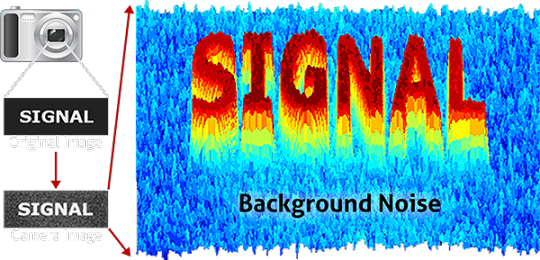
The image above has a sufficiently high SNR to clearly separate the image information from background noise. A low SNR would produce an image where the "signal" and noise are more comparable and thus harder to discern from one another.

ERMINOLOGY: ISO SPEED
A camera's "ISO setting" or "ISO speed" is a standard which describes its absolute sensitivity to light. ISO settings are usually listed as factors of 2, such as ISO 50, ISO 100 and ISO 200 and can have a wide range of values. Higher numbers represent greater sensitivity and the ratio of two ISO numbers represents their relative sensitivity, meaning a photo at ISO 200 will take half as long to reach the same level of exposure as one taken at ISO 100 (all other settings being equal). ISO speed is analogous to ASA speed for different films, however a single digital camera can capture images at several different ISO speeds. This is accomplished by amplifying the image signal in the camera, however this also amplifies noise and so higher ISO speeds will produce progressively more noise.
TYPES OF NOISE
Digital cameras produce three common types of noise: random noise, "fixed pattern" noise, and banding noise. The three qualitative examples below show pronounced and isolating cases for each type of noise against an ordinarily smooth grey background.
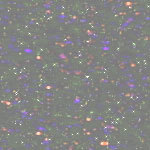
Fixed Pattern Noise Long Exposure Low ISO Speed

Random Noise Short Exposure High ISO Speed

Banding Noise Susceptible Camera Brightened Shadows
2 notes
·
View notes
Link
Sony Alpha a6600 Camera Deals!!
1 note
·
View note
Text
Sony A6600 Review | Gadgets 360
Sony A6600 Review | Gadgets 360
Sony’s Alpha-series APS-C mirrorless cameras have long been popular choices for casual as well as enthusiast photographers, because of their ease of use, very good performance, and portability. Sony has been churning out new iterations of the A6000 series like clockwork and it launched its latest flagship camera, the A6600, in late 2019. This camera builds upon the already powerful A6500 with…

View On WordPress
0 notes
Text
Buy new Sony Alpha A6600 Mirrorless Camera online at best price
Are you looking for a mirrorless camera? Check out the new Sony Alpha A6600 Mirrorless Camera (Body Only) with updated features and performance and comes with the world’s fastest AF speed subject tracking, and broad AF coverage. Order now!
0 notes
Text
MÁY ẢNH SONY
28.500.000₫ Sony A6600 body hàng chính hãng BH tới 6-2023 chụp 7,5k shot Giá 28.500.000�� #thegioimayanhsovn Máy Ảnh Sony Alpha A6600 – Cảm biến Exmor CMOS 24.2MP APS-C – Bộ xử lý hình ảnh BIONZ X – Video UHD 4K30p với Gamma HLG & S-Log3 – XGA Tru-Finder 2.36m-Dot OLED EVF – Màn hình cảm ứng nghiêng 180 ° – ổn định 5 trục SteadyShot – Chụp lên tới 11 khung hình / giây – ISO 100-32000 – FOCUS 4D…
View On WordPress
0 notes